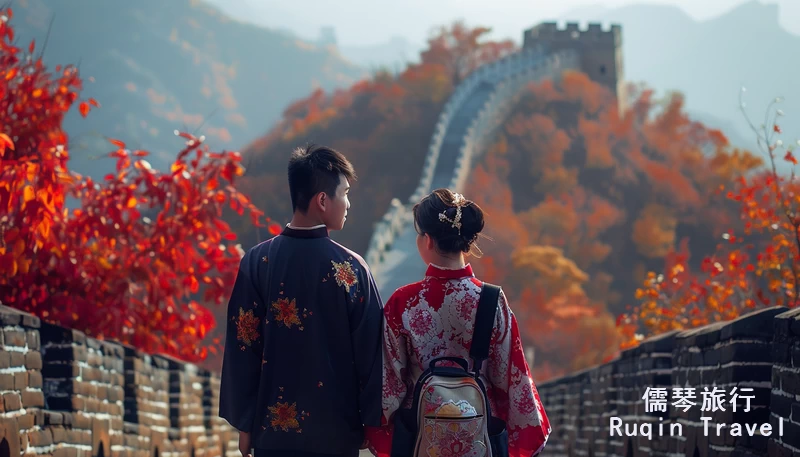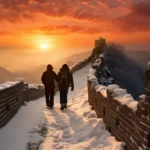Traditional Chinese clothing is a fascinating aspect of Chinese culture. For foreign tourists planning to visit China, understanding this aspect can enrich their travel experience.
This guide will provide insights into the various types of traditional Chinese clothing, their historical significance, and practical tips on what to wear when visiting China. Let’s embark on this cultural journey.
A Brief History of Chinese Clothing
Chinese clothing has a rich history that spans thousands of years. Each dynasty contributed unique styles and elements to traditional attire.
For instance, the Han dynasty introduced the Hanfu, while the Qing dynasty popularized the Qipao. Additionally, various ethnic minorities in China have their traditional clothing, adding to the diversity.
The Hanfu Clothing
The Hanfu is one of the oldest and most traditional Chinese garments. Originating during the Han dynasty (202 BC – 9 AD, 25–220 AD), it features a long, flowing robe with wide sleeves and a crossed collar. Hanfu can be worn by both men and women. In modern times, Hanfu has seen a resurgence in popularity, especially among young Chinese.
Wearing Hanfu requires some practice. First, put on the inner garment. Next, drape the robe over your shoulders and cross the collars. Secure it with a sash around the waist. Finally, adjust the sleeves and the hem to ensure they flow gracefully.
The Qipao Dress
The Qipao, also known as Cheongsam, is another iconic Chinese garment. It became popular during the Qing dynasty (1644-1911). The Qipao is a form-fitting dress with a high collar and side slits. It is typically made of silk or other fine fabrics and often features intricate embroidery.
Today, the Qipao is often worn during special occasions like weddings and festivals. Modern designs have adapted to contemporary fashion trends, making the Qipao a versatile garment.
The Tang Suit
The Tang suit, though not from the Tang dynasty ( 618 – 907), is inspired by traditional Chinese jackets. It features a mandarin collar and frog buttons. The Tang suit is popular during Chinese New Year and other cultural events. It symbolizes Chinese heritage and pride.
Traditional Chinese Garments for Festivals
Chinese festivals often see people wearing traditional clothing. For instance, during the Chinese New Year, it is common to see people in red Qipao or Tang suits, as red symbolizes good luck. During the Mid-Autumn Festival, Hanfu is a popular choice.
Chinese Clothing Etiquette
Understanding Chinese clothing etiquette can enhance your travel experience. When visiting temples or participating in cultural events, wearing traditional clothing can show respect. However, it is important to wear it correctly.
What to Wear in China
When planning what to wear in China, consider the climate and cultural norms. In big cities like Beijing and Shanghai, modern clothing is common. However, in rural areas and during cultural festivals, traditional clothing might be more appropriate.
China Travel Clothing Tips
- Comfort First: Wear comfortable shoes as you might walk a lot.
- Layer Up: Weather can vary, so layering your clothing is a good idea.
- Respect Cultural Sites: Dress modestly when visiting temples and historical sites.
Ancient Chinese Costumes
Ancient Chinese costumes were elaborate and symbolic. They often indicated the wearer’s social status and profession. For instance, imperial robes were richly decorated with dragon motifs, symbolizing power and authority.
The Influence of Dynasties
Each Chinese dynasty brought its own style to traditional clothing. The Tang dynasty was known for its vibrant colors and luxurious fabrics. The Song dynasty favored simplicity and elegance. The Ming dynasty reintroduced the Hanfu, emphasizing traditional Chinese aesthetics.
Chinese Cultural Attire in Modern Times
In modern China, traditional clothing is making a comeback. Young people are embracing Hanfu and Qipao, blending traditional elements with modern fashion. This trend reflects a growing interest in Chinese heritage.
Traditional Chinese Dress for Tourists
As a tourist, wearing traditional Chinese clothing can be a fun way to immerse yourself in the culture. Many shops offer rental services, so you can try Hanfu or Qipao for a day. Additionally, taking photos in traditional attire can make for memorable souvenirs.
Where to Buy Traditional Chinese Clothing
In major cities, you can find stores specializing in traditional Chinese clothing. Online platforms also offer a wide range of options. When buying, pay attention to the quality of fabric and craftsmanship.
The Significance of Colors and Patterns
Colors and patterns in traditional Chinese clothing are not just decorative. They carry significant meaning. For example, red symbolizes happiness and prosperity, while blue represents immortality. Patterns like dragons and phoenixes symbolize power and beauty.
When choosing a traditional Chinese outfit, consider the occasion. For formal events, a Qipao or Tang suit might be appropriate. For casual outings or festivals, Hanfu can be a good choice.
Chinese Traditional Dress Code
Understanding the traditional dress code can help you fit in better during cultural events. For instance, during weddings, wearing red is common. During funerals, white is the traditional color. These customs reflect deep cultural values and respect for traditions.
When wearing traditional Chinese clothing, it is important to do so respectfully. Avoid mixing it with casual, modern accessories. Additionally, try to understand the cultural significance behind the attire.
Traditional Chinese clothing offers a window into the rich cultural heritage of China. As a foreigner visiting China, embracing these traditional garments can enhance your travel experience. Whether it’s the elegant Hanfu, the stylish Qipao, or the classic Tang suit, each piece of clothing tells a story of China’s history and traditions.
By following this guide, you can make informed choices about what to wear and how to wear it. Remember to respect the cultural significance of traditional attire and enjoy the unique experience it offers. Happy travels! Check out China Cultural Insights for more information.
More China Cultural Insights
China is a country full of rich traditions, colorful festivals, and fascinating customs that have been passed down through generations. At China Cultural Insights by Ruqin China Travel, we want to help you experience the real China by understanding its culture.



